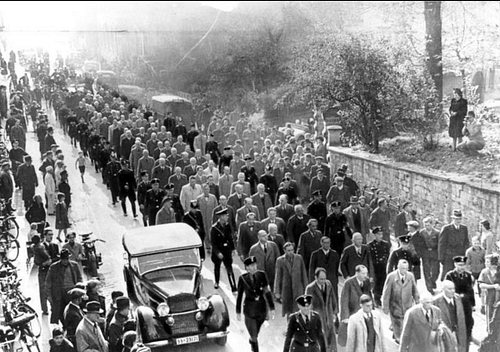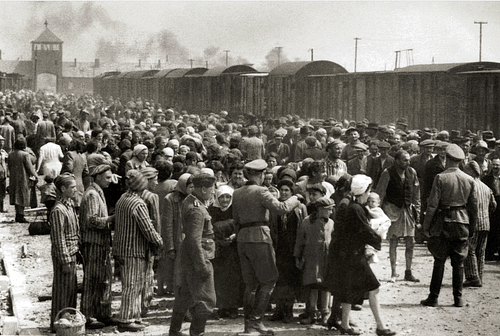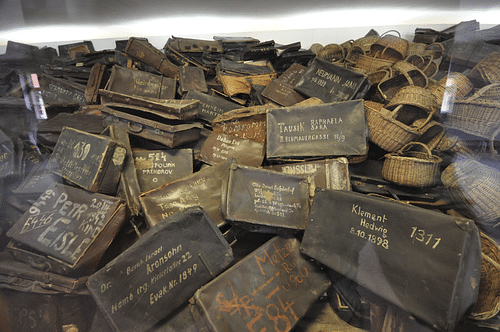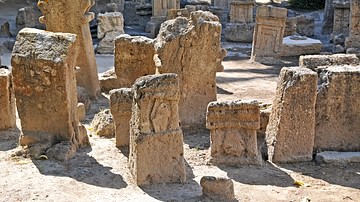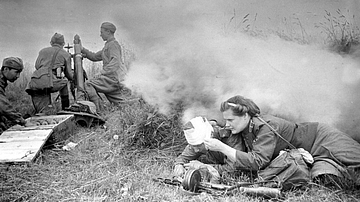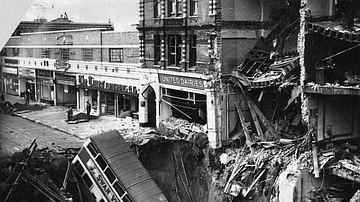The Holocaust was the murder of 6 million Jewish people by the SS, Gestapo, and other organisations of Nazi Germany and its allies in the years prior to and through the Second World War (1939-45). Innocent men, women, and children were shot in mass executions, or, if not too young or too old, they were sent to labour camps where they worked until they could do so no longer. The ultimate fate of millions was to die in the gas chambers of extermination camps like Auschwitz in occupied Poland.
In this article, accounts are presented by those who witnessed the Holocaust genocide firsthand, both its victims and those involved in its execution who were obliged to give evidence in, for example, the post-war Nuremberg trials of 1945-6.
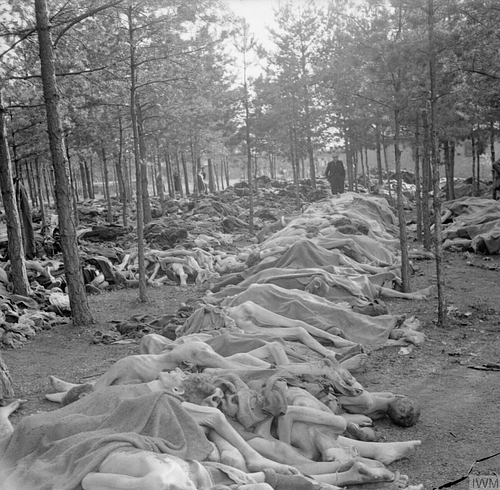
The Nazis & the Jews
Adolf Hitler (1889-1945) established himself as the dictator of Nazi Germany in 1933, and he identified Jewish people as the main enemy of the state. Based on dubious and inconsistent racial theory as propounded by such Nazi figures as Alfred Rosenberg (1893-1946), Hitler and the Nazi Party began a propaganda campaign against German Jews, which presented them as an inferior race who were holding Germany back from achieving its full economic potential.
Hitler wanted to remove all Jews from German territory, but the first step was to identify who exactly was a Jew. The 1935 Nuremberg Laws loosely identified Jews since having three Jewish grandparents placed an individual in that category. A series of 'solutions' to what Hitler called the "Jewish problem" were rolled out, such as encouraging emigration and persecuting Jewish business owners. Jews were then attacked in such pogroms as the Kristallnacht of November 1938. Next, Jews were rounded up and obliged to live in segregated areas such as ghettos in cities or in concentration camps. Jews were deprived of citizenship and other basic rights.
From 1942, the Nazis began what was secretly described as the 'Final Solution', that is the plan to murder all European Jews. Jews were transported to labour camps where they worked on state projects until they died from disease, extreme malnutrition, or physical exhaustion. Other Jews, and those who could no longer work or were too young or too old to work, were transported directly to camps like the Auschwitz complex in occupied Poland where they were killed in gas chambers and their remains were communally cremated. Jews were not the only victims since the Nazis also targeted Romani people, Communists, Jehovah's Witnesses, Freemasons, homosexuals, political rivals, prisoners of war, and those with physical or mental disabilities, amongst others. In addition, hundreds of thousands more victims were murdered in mass executions in occupied territories during the Second World War by mobile killing squads known as Einsatzgruppen. The Jews made up by far the majority of those killed, and it is estimated that 6 million died in what is today called the Holocaust. The sheer scale of the Nazis' programme means that determining the precise number of victims is not possible.
Hugh Greene, a British newspaper journalist, recalls what he saw of the Kristallnacht in 1938:
I was in Berlin at that time and saw some pretty revolting sights – the destruction of Jewish shops, Jews being arrested and led away, the police standing by while the gangs destroyed the shops and even groups of well-dressed women cheering.
(Holmes, 42)
Avraham Aviel, a Polish Jew and survivor of a mass execution, gives the following account of his experience in May 1942:
We were all brought close to the cemetery at a distance of eighty to a hundred metres from a long, deep pit. Once again everybody was made to kneel. There was no possibility of lifting one's head. I sat more or less in the centre of the town people. I looked in front of me and saw the long pit then maybe groups of twenty, thirty people led to the edge of the pit, undressed probably so that they should not take their valuables with them. They were brought to the edge of the pit where they were shot and fell into the pit, one on top of another.
(Holmes, 319)
An anonymous survivor from a ghetto massacre in Lviv, Ukraine, in August 1942 gives the following description of its aftermath:
I went with my mother to the office of the Jewish community regarding an apartment and there in the light breeze, dangled the corpses of the hanged, their faces blue, their heads tilted backward, their tongues blackened and stretched out. Luxury cars raced in from the center of the city, German civilians with their wives and children came to see the sensational spectacle, and, as was their custom, the visitors enthusiastically photographed the scene. Afterwards the Ukrainians and Poles arrived by with greater modesty.
(Fiedländer, 436)
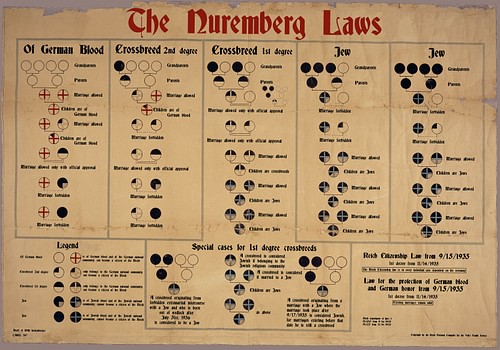
Rivka Yoselevska, a Polish Jew, describes her experience and that of her family in the Hansovic ghetto massacre in August 1943:
Some of the younger ones [children] tried to run away. They hardly managed a few steps, they were caught and shot. Then came our turn. It was difficult to hold the children, they were shaking….We were lined up in fours. We were stood there naked. Our clothing was taken away. My father didn't want to undress completely and kept on his underwear. When he was lined up for the shooting and was told to undress, he refused; he was beaten…They tore his things off him and shot him. Then they took mother. She didn't want to go, but wanted us to go first. Yet we made her go first. They grabbed her and shot her. There was my father's mother who was eighty with two grandchildren in her arms. My father's sister was also there. She, too, was shot with children in her arms. Then my turn came. My younger sister also. She had suffered so much in the ghetto, and yet at the last moment she wanted to stay alive, and begged the German to let her live. She was standing there naked holding on to her girl friend. So he looked at her and shot them both. Both of them fell, my sister and her girl friend. My other sister was next…He got ready to shoot me...He tore the child away from me. I heard her last cry and he shot her. Then he got ready to kill me…turned me around and shot me. I fell down [into the pit of corpses]. I felt nothing….bodies had fallen on me. I felt I was drowning…[Later] I got out naked covered with blood…I was still alive. Where should I go? What should I do?
(Holmes, 320-1)
The SS lieutenant-colonel Adolf Eichmann (1906-1962), in charge of the Final Solution's transportation requirements, here lies to Jews to make sure they do not create trouble as they are transported by train from a ghetto to the concentration camps:
Jews: You have nothing to worry about. We want only the best for you. You'll leave here shortly and be sent to very fine places indeed. You will work there, your wives will stay at home, and your children will go to school. You will have wonderful lives.
(Bascomb, 6)
The death camps were deliberately located in remote Poland to provide the Final Solution project more secrecy. Rudolf Höss (1901-1947), a camp commandant at Auschwitz, stated:
We were required to carry out these exterminations in secrecy, but of course the foul and nauseating stench from the continuous burning of bodies permeated the entire area and all of the people living in the surrounding communities knew that exterminations were going on at Auschwitz.
(Neville, 49)
The typical conditions of the train journeys to the camps are described here by Avraham Kochav, an Auschwitz survivor:
There were twenty to twenty-five cars in every train…I heard terrible cries. I saw how people attack other people so as to have a place to stand, how people push each other so that they could stand somewhere or so that they could have air for breathing. It was terribly, terribly stifling. The first to faint were the children, women, old men, they all fell down like flies.
(Holmes, 332)
Zygmunt Klukowski, a Polish hospital director, describes the train journeys for Jewish people sent to the Belzec extermination camp in occupied Poland:
On the way to Belzec the Jews experience many terrible things. They are aware of what will happen to them. Some try to fight back. At the railroad station in Szczebrzeszyn a young woman gave away a gold ring in exchange for a glass of water for her dying child. In Lublin people witnessed small children being thrown through windows of speeding trains. Many people are shot before reaching Belzec.
(Friedländer, 358)
Yaacov Silberstein, a Jewish teenager, describes his arrival at Auschwitz in October 1942:
When we arrived we saw how the Jews were running to the electrified fence. There they stuck. They were tired of life; they could not continue in this fashion.
(Holmes, 330)
Dr Lucie Adelsberger, a prisoner of Auschwitz, describes the processing of new arrivals destined for the labour camps:
We undressed, had our hair cut – no actually our heads were shaved to stubble; then came the showers and finally the tattoos. This was where they confiscated the very last vestiges of our belongings; nothing remained…no written document that could have identified us, no picture, no written message from a loved one. Our past was cut off, erased…
(Cesarini, 656)
Bernd Naumann, a survivor from the Birkenau camp, describes the prevalence of rats in the camp:
They gnawed not only at corpses but also at the seriously sick. I have pictures showing women near death being bitten by rats.
(Neville, 50)
Seweryna Smaglewska, a prisoner in the Birkenau women's camp, describes the living conditions there:
There were no roads, no paths between the blocks. In the depths of these dark dens, in bunks like multi-storied cages, the feeble light of a candle burning here or there flickered over naked, emaciated figures curled up, blue from the cold, bent over a pile of filthy rags, holding their shaved heads in their hands, picking out an insect with their scraggly fingers and smashing it on the edge of the bunk – that is what the barracks looked like in 1942.
(Cesarini, 528)
The SS, which managed the camps, made sure there was a hierarchy amongst the prisoners such as trustees who survived a little longer than the rest by being 'favoured' with certain duties such as burning the bodies in the crematoriums or beating other prisoners. SS Lance Corporal Richard Bock, a guard at Auschwitz, recalls:
A block chief would call out the kapo [prisoner trustee] very fiercely, 'Kapo, come here.' The kapo came over and – boom – he hit the kapo in the face so hard that he fell over…And then he said, 'Kapo, can't you beat them any better than that?' And the kapo ran off and grabbed a club to beat up the prisoner squad quite indiscriminately. 'Kapo, come over here,' he shouted again. The kapo came and he said, 'Finish them off,' and then he went off again and he finished the prisoners off, he beat them to death…a kapo had to beat and club to save his own life.
(Holmes, 325)
Those meant for the gas chambers were often unaware of their fate. Bock describes the procedure that he witnessed with a colleague called Holbinger who was responsible for the Zyklon B tins that would produce the lethal gas:
…the new arrivals had to get undressed, and then the order came, 'Prepare for disinfection'. There were enormous piles of clothing…Lots of them hid their children under the clothes and covered them up and then they shouted, 'Get ready' and they all went out, they had to run naked approximately twenty yards from the hall across to Bunker One. There were two doors standing open and they went in there and when a certain number had gone inside they shut the doors. That happened about three times, and every time Holbinger had to go out to his ambulance and they took out a sort of tin – he and one of his block chiefs – and then he climbed up the ladder and at the top there was a round hole and he opened the little round door and held the tin there and shook it and then he shut the little door again. Then a fearful screaming started up and approximately after about ten minutes it slowly went quiet…They opened the door…then a blue haze came out. I looked in and I saw a pyramid. They had all climbed up on top of each other…They were all tangled, they had to tug and pull very hard to disentangle all these people.
(Holmes, 334-5)
Dov Paisikowic, a Russian-Jewish survivor of Auschwitz, was part of the team responsible for taking bodies out of the chambers, removing valuables such as rings and gold teeth, and then taking the corpses to the crematoria. He recalls:
…the doors were suddenly opened to the gas chambers. People, naked people, started falling out. We were all frightened, no one dared ask what it all was. We were immediately taken to the other side of this house and there we saw hell on this earth – large piles of dead people, and people dragging these dead to a long pit, about thirty metres in length and ten metres in width. There was a huge fire there, with tree trunks. On the other side fat was being taken out of this pit with a bucket.
(Holmes, 335)
Thousands of detainees in the camps were subjected to unnecessary and often horrific medical operations and experiments. One of the most infamous SS doctors was Josef Mengele (1911-1979), who performed all kinds of macabre operations at Auschwitz. Mengele was, though, only one part of a large SS medical team, which operated in many different camps. Dr Franz Blaha, a Czech detainee at the Dachau concentration camp, was obliged to work in this area of Nazi terror, specifically performing autopsies. Blaha reported:
From the middle of 1941 to the end of 1942 some 500 operations on healthy prisoners were performed. These were for the instructions of the SS medical students and doctors and included operations on the stomach, gall bladder and throat. These were performed by students and doctors of only two years' training, although they were very dangerous and difficult….Many prisoners died on the operating table and many others from later complications…These persons were never volunteers but were forced to submit to such acts.
(MacDonald, 59)

Hertha Beese, a Berlin housewife and underground resistance worker, recalls that, unlike the general public, the resistance network was more informed about the camps. She states:
We knew that the concentration camps existed. We also knew where they existed, for example Oranienburg just outside Berlin. We sometimes knew which of our friends were there and we also knew of the cruelties in them right from the beginning.
(Holmes, 315)
Anthony Eden (1897-1977), British Foreign Secretary during WWII, notes:
…as the war progressed some horrifying reports began to come out. At first it was very difficult to assess their accuracy and they were so horrible it was hard to believe they could be true.
(Holmes, 314)
Wynford Vaughn-Thomas, a British journalist, recalls the conditions of the Bergen-Belsen concentration camp in Germany when it was liberated in 1945:
In the huts typhoid, everything, had broken out and you couldn't hear yourself speak for the death rattle. There were people lying on top of each other, sick, vomiting, withered bodies crawling on their hands and knees…It was sealed off in this dark north German plain and you felt you'd reached the cesspit of the human mind.
(Holmes, 337)

The British Lieutenant Colonel J. A. D. Johnson described what he saw when he arrived at Bergen-Belsen:
The prisoners were a dense mass of emaciated apathetic scarecrows huddled together in wooden huts, and in many cases without beds or blankets, and in some cases without any clothing whatsoever…There were thousands of emaciated corpses in various stages of decomposition lying unburied. Sanitation was to all intents and purposes nonexistent.
(Cesarini, 759)
Hans Stark, Gestapo staff member at Auschwitz, stated, like so many others, that he had merely been following orders:
I took part in the murder of many people…I believed in the Führer, I wanted to serve my people. Today I know that this idea was false. I regret the mistakes of my past, but I cannot undo them.
(Neville, 57)
Rabbi Frankforter, who died in the Holocaust, which Jewish people often call the Shoah or Ha-Shoah in Hebrew, gave this last wish to survivor Yaacov Silberstein:
You are still young and you will remain alive. I have only one request for you that you should never let people forget. Tell everyone what they did to us at this small camp, in Buchenwald. Wherever you go tell this, also to your children so that they should pass it on. To remember and not to forget.
(Holmes, 339)
